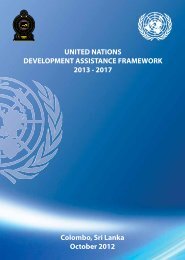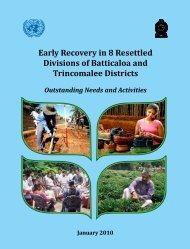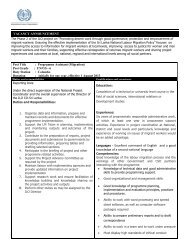Sri Lanka Human Development Report 2012.pdf
Sri Lanka Human Development Report 2012.pdf
Sri Lanka Human Development Report 2012.pdf
Create successful ePaper yourself
Turn your PDF publications into a flip-book with our unique Google optimized e-Paper software.
towards constructing multipurpose reservoirs. 9 major<br />
and 18 medium irrigation schemes began after 2006, on<br />
top of the completion of work that started beforehand.<br />
This facilitates cultivation of 26,000 hectares, benefitting<br />
30,000 families. 249<br />
Accessibility to economic centers<br />
Good quality infrastructure determines a region’s<br />
connectivity to economic centres. Infrastructure and<br />
connectivity are, in turn, two of the ingredients that boost<br />
an economy’s competitiveness and its ability to generate<br />
employment. 250 The World Bank, which views poor<br />
infrastructure as a key constraint to businesses in both<br />
urban and rural areas of <strong>Sri</strong> <strong>Lanka</strong>, found that geographic<br />
isolation and long travel times to Colombo are correlated<br />
with high poverty outside of the capital. 251<br />
A well-functioning road network is important for both<br />
finished products and raw materials to reach markets.<br />
Overall, <strong>Sri</strong> <strong>Lanka</strong>’s road infrastructure is considered<br />
adequate in rural and urban areas. However, the road<br />
congestion -- in terms of number of vehicles per kilometer<br />
of road -- is somewhat high, at 90 vehicles per kilometer<br />
of road in year 2010. 252 This is considerably less than<br />
232 and 165 vehicles per road kilometer in Singapore<br />
and Republic of Korea, respectively, for the year 2009.<br />
However, it is higher than in 5 and 8 vehicles per road<br />
kilometer in India and Pakistan respectively for the years of<br />
2008 and 2009. 253<br />
For accessibility, the availability of roads is as important<br />
as their capacity, but for rural roads, where capacity is less<br />
of an issue, availability is more important. Road density<br />
measured as the length per geographical area is commonly<br />
used as an index of availability. Density is lowest for the<br />
North Western and Sabaragamuwa provinces, and highest<br />
for the Central and Western provinces (Figure 5.7). The<br />
roads of the Western Province are more congested, as it<br />
has the highest population per kilometer of road, and the<br />
highest number of vehicles per kilometre of road.<br />
90<br />
sri lanka <strong>Human</strong> <strong>Development</strong> report 2012






